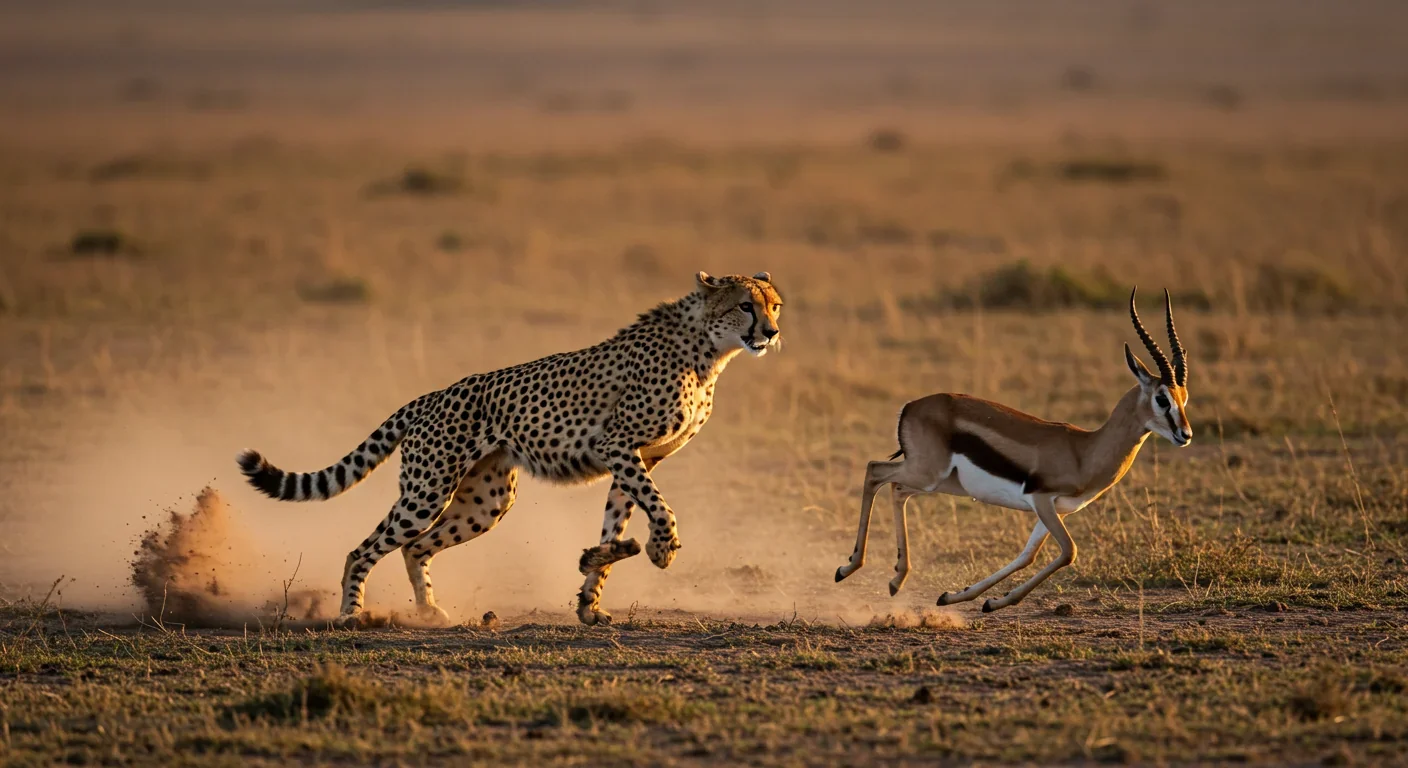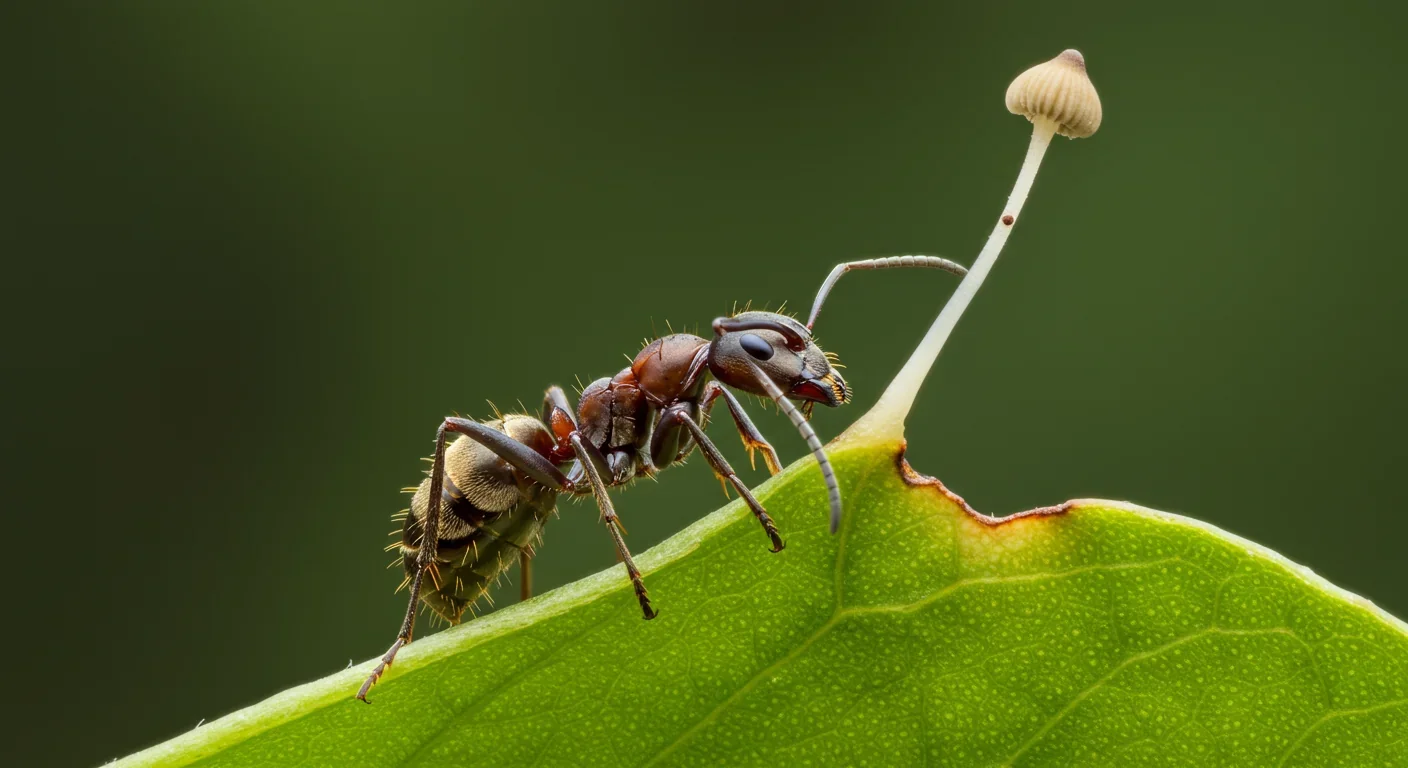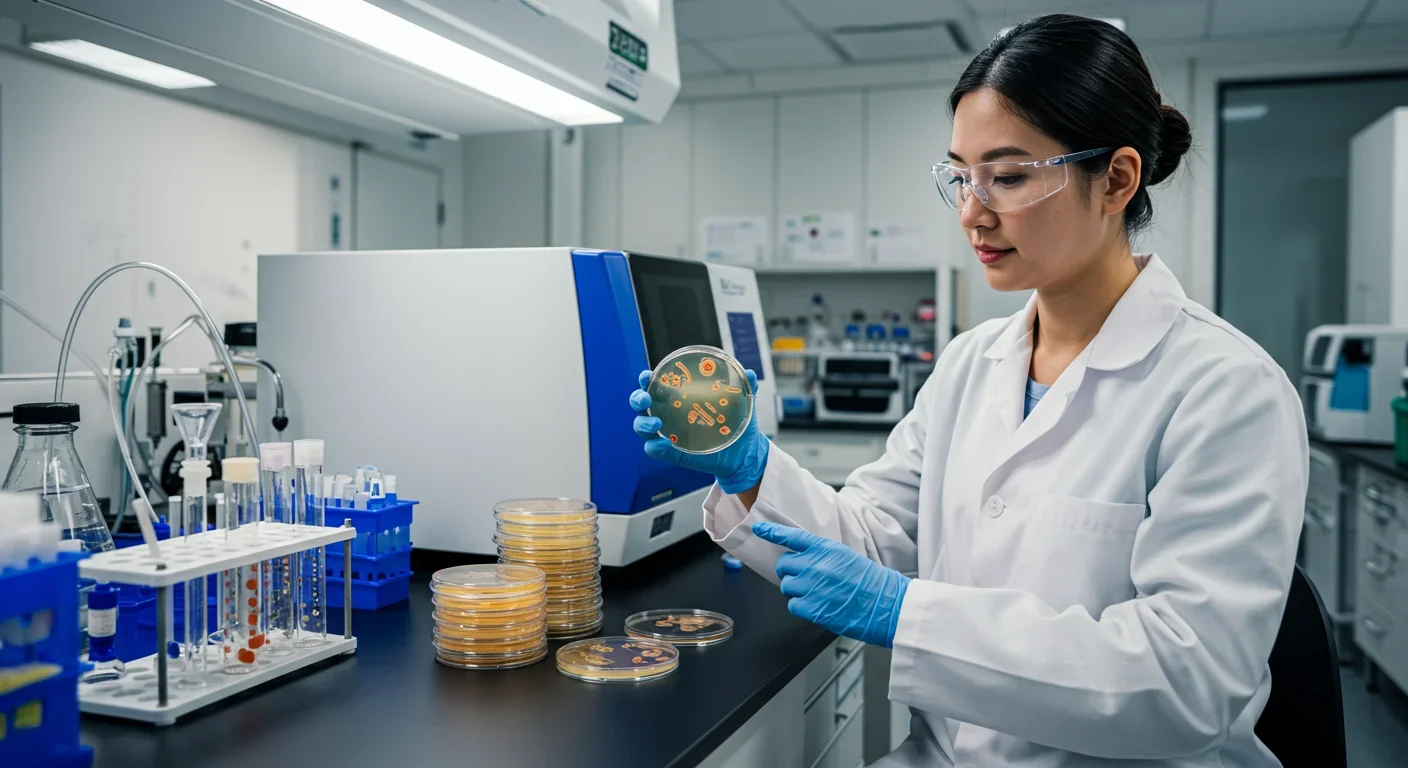Why Your Brain Sees Gods and Ghosts in Random Events

TL;DR: Evolutionary arms races between species drive continuous adaptation and innovation across all ecosystems. From malaria parasites evading human immunity to plants deploying chemical defenses against insects, these conflicts shape biodiversity and offer crucial lessons for medicine, agriculture, and conservation.

Imagine you're a gazelle grazing peacefully when suddenly, a cheetah explodes from the tall grass. Your heart pounds. Your muscles fire. You sprint for your life at speeds that would leave most cars struggling to keep up. This chase isn't just about survival today—it's the culmination of millions of years of escalating competition, where every generation of predator pushes prey to evolve faster legs, and every generation of prey forces predators to evolve more explosive acceleration. Welcome to nature's arms race, where the stakes are survival itself and the battlefield spans every ecosystem on Earth.
Evolutionary arms races aren't abstract concepts confined to textbooks. They're dynamic, ongoing battles that shape everything from the bacteria in your gut to the apex predators prowling the savannah. The term describes what happens when two or more species exert selective pressure on each other, driving continuous adaptation and counter-adaptation.
Think of it like a biological chess match where both players keep inventing new pieces. When prey species develop better defenses, predators must evolve better offense. When hosts build immunity, parasites devise new ways to evade detection. The process creates what evolutionary biologists call reciprocal selection—changes in one species directly influence survival odds in another, creating a feedback loop that accelerates evolution on both sides.
The mechanisms driving these conflicts are surprisingly diverse. Some arms races center on physical traits like speed or strength. Others involve chemical warfare, with plants synthesizing toxins and insects evolving resistance. Still others play out at the molecular level, invisible to the naked eye but no less consequential.
Recent research has revealed just how fast these evolutionary battles unfold. Genetic studies of malaria parasites show that Plasmodium falciparum can accumulate mutations at remarkable speeds, allowing it to dodge both human immune systems and antimalarial drugs. Meanwhile, mosquito vectors adapt their behavior and biochemistry to resist insecticides, demonstrating that evolutionary arms races continue in real time, even as we watch.
Few examples illustrate evolutionary arms races more dramatically than malaria. This disease isn't just a simple infection—it's the visible outcome of a complex dance among humans, mosquitoes, and microscopic parasites, each evolving strategies to outmaneuver the others.
Human populations have been under selective pressure from malaria for millennia. The result? A stunning array of genetic defenses. You've probably heard of sickle cell trait, but that's just one adaptation among many. Populations in malaria-endemic regions carry diverse immune-related gene variants that help fight off infection or reduce disease severity. These genetic changes reflect generations of natural selection, where individuals with protective mutations had better odds of surviving and passing on their genes.
The parasite, though, refuses to stay still. Plasmodium falciparum has evolved elaborate systems for antigenic variation—essentially changing its molecular disguise to evade immune recognition. It can switch which proteins it displays on infected red blood cells, staying one step ahead of antibodies. This genetic flexibility also accelerates drug resistance, as mutations spread rapidly through parasite populations when drugs create strong selective pressure.
And the mosquitoes? They're evolving too. Anopheles vectors have developed resistance to insecticides through multiple mechanisms, including enhanced metabolic detoxification that breaks down chemicals before they can kill. Some populations have even changed their feeding behavior, biting outdoors or during daytime hours to avoid treated bed nets. It's a three-way arms race where every advance by one player triggers counter-adaptations in the others.
The predator-prey arms race produces some of nature's most spectacular athletes. Cheetahs can accelerate from zero to 60 mph in three seconds—faster than most sports cars. Gazelles execute evasive maneuvers at full sprint, zigzagging unpredictably to throw off pursuers. Both abilities emerged from relentless selective pressure: slow predators starve, slow prey become dinner.
But here's where it gets interesting. Research on island lizards reveals what happens when you remove predators from the equation. Lizards on islands without snakes show significantly reduced sprint speeds compared to mainland relatives that face constant predation pressure. It's direct evidence that arms races drive performance—when the pressure disappears, so does the need for extreme speed.
The pattern repeats across ecosystems. Bats evolved echolocation to hunt insects in darkness. Some moths responded by evolving ears tuned to ultrasonic frequencies, giving them early warning of approaching predators. Other moths took a different approach, developing scales that absorb sound waves, essentially creating stealth technology millions of years before human engineers invented it.
These physical arms races create what biologists call an evolutionary ratchet. Each improvement by one side makes the other side's job harder, driving continuous refinement of traits. The result? Organisms with capabilities that seem almost miraculous—until you realize they emerged from countless generations of life-or-death competition.

Plants can't run from their enemies, so they've evolved a different strategy: chemical warfare. And the sophistication of these defenses would impress any military strategist.
Take tea plants as an example. When insects begin feeding, specialized receptors detect molecules in insect saliva and trigger a cascade of defensive responses. The plant rapidly synthesizes compounds that taste terrible, interfere with digestion, or even attract predators that eat the herbivores. This induced defense system demonstrates that plants can distinguish between mechanical damage (like wind) and actual herbivore attacks, responding only when the threat is real.
Herbivorous insects, meanwhile, have evolved counter-strategies. Some secrete compounds that suppress plant defenses. Others sequester plant toxins in their own tissues, turning defensive chemicals into their own weapons against predators. Recent studies show that parasitoid wasps have joined this chemical arms race, using antimicrobial peptides to manage both their insect hosts and any plant defenses the hosts might have accumulated.
The fig-wasp relationship showcases how intricate these co-evolutionary dances can become. Figs have evolved specialized structures that mediate interactions with pollinators, creating both opportunities for cooperation and potential for exploitation. Fig wasps have evolved to recognize chemical signals from specific fig species, while figs have evolved mechanisms to ensure pollinators deliver their service before receiving rewards.
This pattern extends beyond individual plant-insect pairs. Research on alpine grasslands reveals that entire communities of plants and pollinators show trait matching—flower characteristics align with the capabilities and preferences of local pollinator groups. These associations reflect long evolutionary histories where both parties shaped each other's traits.
Some of evolution's most disturbing arms races happen inside organisms' bodies and brains. Parasites have evolved strategies that border on science fiction, manipulating host behavior to enhance their own reproductive success.
Consider the parasitic barnacle Loxothylacus panopaei, which infects mud crabs and essentially transforms them into zombie caregivers. The barnacle castrates the crab, redirects its energy to parasite reproduction, and alters its behavior so it protects and tends the barnacle's offspring as if they were its own eggs. Male crabs infected with this parasite even develop maternal behaviors, carefully fanning and grooming the parasite's egg mass.
Or take Ophiocordyceps fungi, which infect ants and hijack their nervous systems. Infected ants abandon their colonies, climb vegetation, and bite down on leaves in specific locations that optimize fungal sporulation. The fungus then erupts from the ant's head, showering spores onto ants passing below. The precision of this manipulation suggests millions of years of refinement—the fungus must not only invade the ant's brain but also execute a complex behavioral program at just the right time and place.
These manipulation strategies represent extreme adaptations in the parasite-host arms race. Hosts evolve immune defenses and behavioral resistance, while parasites evolve ever more sophisticated methods of invasion and control. The evolutionary stakes are enormous: successful parasites reproduce prolifically, while effective host defenses prevent infection entirely.
Recent research reveals the molecular mechanisms behind such manipulation. Studies of parasitoid wasps show they inject cocktails of proteins, venoms, and symbiotic viruses that reprogram host development and immunity. Some wasp species carry polydnaviruses that integrate into host genomes, effectively turning the host into a customized incubator for wasp larvae.
Evolutionary arms races don't just shape individual traits—they drive the creation of entirely new species. The process, called coevolutionary diversification, occurs when conflicting selection pressures in different environments cause populations to diverge.
Orchids and their pollinators provide a textbook example. Many orchid species have evolved flowers shaped precisely to match specific pollinator body types and behaviors. Some orchids even mimic female insects, complete with appropriate scents and textures, to trick males into attempted mating that results in pollination. This tight coevolution has contributed to the incredible diversity of orchids—with over 25,000 species, they're one of the largest plant families on Earth.
But here's the catch: highly specialized relationships create evolutionary traps. When an orchid becomes completely dependent on a single pollinator species, both become vulnerable. If the pollinator goes extinct, so does the orchid. This interdependence explains why conservation biologists worry about disrupting pollinator networks—breaking one link can cascade through entire ecosystems.
The phenomenon isn't limited to plants and pollinators. Parasitoid wasps and their caterpillar hosts show similar patterns of coevolutionary diversification. Different wasp species have evolved to exploit different host species, each developing specialized tools for overcoming that particular host's defenses. The result is a staggering diversity of both wasps and defensive strategies in their hosts.
Arms races also generate what biologists call "Red Queen dynamics," named after the character in Lewis Carroll's Through the Looking-Glass who must keep running just to stay in place. In evolutionary terms, this means species must continually adapt just to maintain their current fitness as opponents evolve. Research on water fleas and their parasites demonstrates this beautifully—host and parasite populations show cyclical genetic changes as each adapts to the other's latest innovations.

Understanding evolutionary arms races isn't just academically interesting. It has profound implications for agriculture, medicine, and conservation—areas where humans are often unwitting participants in these ancient conflicts.
Antibiotic resistance is perhaps the clearest example. When we use antibiotics, we create intense selective pressure favoring bacteria that can survive the drugs. Recent studies of bacterial evolution reveal something counterintuitive: sometimes losing certain genes actually increases bacterial fitness. When a strain of Pseudomonas aeruginosa lost an efflux pump (a protein that normally pumps toxins out of cells), it became more virulent and competitive because it saved energy by not producing an unnecessary structure in drug-saturated environments.
This finding highlights why arms races with pathogens are so difficult to win. Evolution explores all possible solutions, including ones that seem paradoxical from an engineering perspective. Bacteria don't just develop resistance through acquiring new genes—they can also gain advantages by shedding genes that are energetically costly when drugs change the rules of the game.
Agricultural pest management faces similar challenges. When farmers apply insecticides uniformly across large areas, they create perfect conditions for resistance evolution. The solution? Integrated pest management that incorporates multiple strategies—chemical controls, biological controls, crop rotation, and resistant crop varieties—to prevent pests from adapting to any single pressure.
Conservation biology must also account for arms race dynamics. When we protect prey species but not predators, we may inadvertently relax selection pressures that maintain important traits. Studies of island animals demonstrate that populations isolated from predators can lose defensive adaptations within dozens of generations. If we later want to reintroduce predators or move these animals to predator-rich habitats, they'll be at a severe disadvantage.
Climate change adds another layer of complexity. As temperatures shift and habitats transform, species interactions change, potentially disrupting long-established coevolutionary relationships. Pollinators and plants may fall out of sync if warming causes them to emerge at different times. Parasites might expand into new geographic ranges faster than their hosts can evolve defenses.
As we move forward, our understanding of evolutionary arms races will likely transform how we approach some of humanity's biggest challenges. Precision medicine, for instance, might borrow strategies from nature's playbook—using combination therapies that present multiple simultaneous challenges to pathogens, just as ecosystems create multifaceted selective pressures.
Agricultural biotechnology could engineer crops that deploy defenses more strategically, mimicking the induced defense systems that plants evolved naturally. Rather than constitutively expressing toxins that waste energy and drive resistance, engineered crops could activate defenses only when attacked, preserving resources and slowing the evolution of resistance in pest populations.
In vector control, new approaches must account for rapid adaptation. The discovery that mosquitoes can evolve behavioral resistance to interventions like bed nets suggests we need dynamic strategies that anticipate evolutionary responses. This might mean rotating between different control methods, designing interventions that are harder to evolve resistance against, or targeting multiple aspects of mosquito biology simultaneously.
The core lesson from nature's arms races is clear: evolution is fast, creative, and relentless. Any time we create selective pressure—through drugs, pesticides, hunting, or habitat modification—we're entering an evolutionary arms race whether we intend to or not. The question isn't whether organisms will adapt, but how quickly and in what ways.
By studying how species have coevolved over millions of years, we gain insights into the rules governing these conflicts. We learn that diversity slows adaptation by our opponents, that intermittent pressure works better than constant pressure, and that targeting multiple mechanisms simultaneously reduces the odds of resistance.
Perhaps the most humbling realization from studying evolutionary arms races is that there are no permanent victories. Evolution doesn't stop. Every solution we develop—whether it's an antibiotic, a pesticide, or a conservation strategy—is temporary. Organisms we're competing against are constantly probing for weaknesses, randomly generating genetic variants, some of which will inevitably find ways around our defenses.
But there's profound beauty in this dynamic. The cheetah's speed, the orchid's intricate flower, the immune system's ability to remember pathogens—all these marvels emerged from conflict and competition. Evolutionary arms races are engines of innovation, creating complexity and diversity that wouldn't otherwise exist.
For humans, the challenge is learning to work with evolutionary processes rather than against them. We can't stop evolution, but we can design interventions that slow it, direct it, or make it work in our favor. The key is recognizing that we're not separate from nature's endless war games—we're participants, with all the risks and responsibilities that entails.
As we face growing challenges from antibiotic-resistant bacteria, pesticide-resistant pests, and rapidly adapting viruses, the lessons from evolutionary biology become increasingly urgent. Nature has been running these experiments for billions of years. The organisms that survive are the ones that adapt, diversify, and never assume victory is permanent.
That same principle applies to us. Our success depends on remaining humble before evolution's power, staying alert to how our actions create selective pressures, and maintaining the flexibility to change strategies as organisms inevitably evolve in response to our interventions. In nature's endless war games, the only way to avoid losing is to keep learning from every battle—and to remember that the war itself will never end.

Recent breakthroughs in fusion technology—including 351,000-gauss magnetic fields, AI-driven plasma diagnostics, and net energy gain at the National Ignition Facility—are transforming fusion propulsion from science fiction to engineering frontier. Scientists now have a realistic pathway to accelerate spacecraft to 10% of light speed, enabling a 43-year journey to Alpha Centauri. While challenges remain in miniaturization, neutron management, and sustained operation, the physics barriers have ...

Epigenetic clocks measure DNA methylation patterns to calculate biological age, which predicts disease risk up to 30 years before symptoms appear. Landmark studies show that accelerated epigenetic aging forecasts cardiovascular disease, diabetes, and neurodegeneration with remarkable accuracy. Lifestyle interventions—Mediterranean diet, structured exercise, quality sleep, stress management—can measurably reverse biological aging, reducing epigenetic age by 1-2 years within months. Commercial ...

Data centers consumed 415 terawatt-hours of electricity in 2024 and will nearly double that by 2030, driven by AI's insatiable energy appetite. Despite tech giants' renewable pledges, actual emissions are up to 662% higher than reported due to accounting loopholes. A digital pollution tax—similar to Europe's carbon border tariff—could finally force the industry to invest in efficiency technologies like liquid cooling, waste heat recovery, and time-matched renewable power, transforming volunta...

Humans are hardwired to see invisible agents—gods, ghosts, conspiracies—thanks to the Hyperactive Agency Detection Device (HADD), an evolutionary survival mechanism that favored false alarms over fatal misses. This cognitive bias, rooted in brain regions like the temporoparietal junction and medial prefrontal cortex, generates religious beliefs, animistic worldviews, and conspiracy theories across all cultures. Understanding HADD doesn't eliminate belief, but it helps us recognize when our pa...

The bombardier beetle has perfected a chemical defense system that human engineers are still trying to replicate: a two-chamber micro-combustion engine that mixes hydroquinone and hydrogen peroxide to create explosive 100°C sprays at up to 500 pulses per second, aimed with 270-degree precision. This tiny insect's biochemical marvel is inspiring revolutionary technologies in aerospace propulsion, pharmaceutical delivery, and fire suppression. By 2030, beetle-inspired systems could position sat...

The U.S. faces a catastrophic care worker shortage driven by poverty-level wages, overwhelming burnout, and systemic undervaluation. With 99% of nursing homes hiring and 9.7 million openings projected by 2034, the crisis threatens patient safety, family stability, and economic productivity. Evidence-based solutions—wage reforms, streamlined training, technology integration, and policy enforcement—exist and work, but require sustained political will and cultural recognition that caregiving is ...

Every major AI model was trained on copyrighted text scraped without permission, triggering billion-dollar lawsuits and forcing a reckoning between innovation and creator rights. The future depends on finding balance between transformative AI development and fair compensation for the people whose work fuels it.